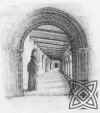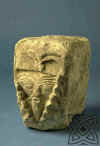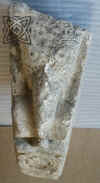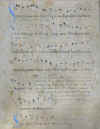|
|
the cloister |
||
|
|
|||
 The cloister was
at the heart of the abbey leading
to the north to the church, to the chapter
house and dormitory on the
east, to the dining room on the south and to the abbot's apartments and
store rooms on the west. This an imaginative drawing of the east
walkway looking southwards with the entrance to the chapter house on the
left. Click on the thumbnail to go to the larger picture. The cloister was
at the heart of the abbey leading
to the north to the church, to the chapter
house and dormitory on the
east, to the dining room on the south and to the abbot's apartments and
store rooms on the west. This an imaginative drawing of the east
walkway looking southwards with the entrance to the chapter house on the
left. Click on the thumbnail to go to the larger picture.
|
|||
|
Daily life for the monks centered on their Cloister. Here was a peaceful garden measuring 30 metres square with a weft at the south. It was surrounded on four sides by covered walkways 5.8 metres wide where the monks moved about their daily business over the glazed floor tiles with their cream patterns on a reddish-brown background. The round arcaded windows looking onto the garden were made of elaborately carved and painted stonework in the 12th century Romanesque style. We can trace a wide variety of sources as inspiration for the sculptors of the stones - a Norse saga telling the story of a fight between men and dragons, patterns from illustrations in manuscripts, the theology of the Trinity and of the Coronation of the Virgin Mary, designs from fabrics imported from Islamic countries, possibly even the decorations from Roman times still to be seen in mosaics of the ruined town of Silchester 8 miles to the south of Reading. |
|||

|
Click on the thumbnail to see the large pictures of some cloister stones. |

|
|
|
The east walkway was the main thoroughfare for the monks from Dormitory to Church and into the Chapter House. The west walkway led to the storehouses and the Abbot's House and was one of the few places in the monastery where talking among the monks could be heard, the Novices, or monks in training, being instructed by their Novice Master. A young man aspiring to be a monk was received into the Abbey in his late teens and had at least a year of experience of the daily life before he could be considered for taking his vows. These committed him to lifelong membership of the community with no possessions of his own, all being supplied to him from his spiritual father the Abbot, never to be married and always under the authority of the Abbot and the will of his brother monks, a life of poverty, chastity and obedience. The south walkway gave onto the Dining Room and contained wash basins with cupboards for towels for the monks to wash before going in for their meals. The north walkway was the warmest and most comfortable. Here the sun shone through the windows and the monks sat between services for their private prayer, reading and meditation. Here also the writing was carried out which was so vital to the life of the Abbey. Accounts and daily records had to he kept, copies of service books and music had to be made and music was also composed, such as the famous earliest recorded four part harmony in Britain, Sumer is icumen in. Copies of the Bible and other religious and scholarly works were produced, in languages of Latin, Greek, French and English, often with elaborately decorated letters starting a chapter. This was the time before printing presses could quickly turn out numerous copies of a text and all books were laboriously written out by hand. We can imagine a large cupboard in the north walkway of the Cloister holding some of the books but the library being so extensive that a special room nearby was needed to hold the rest. A catalogue compiled some 70 years after the Abbey was founded records that nearly 300 volumes were used in the everyday life of the monastery, ranging from Bibles to copies of classical texts to music books. It must be remembered that reading and writing were unusual in those days, most people could neither read nor write and these skills were especially nurtured in monasteries and among the clergy, a fact still remembered in our present-day term, 'clerical work'. Writing continued both summer and winter though there was no heating in the Cloister. Special writing booths or 'carrells' with glass in the windows were built in the later years of the monastery but even so the fingers of elderly monks moved only slowly over the pages when snow covered the garden in the centre. |
|||
|
Left the page of music of "sumer is icumen in" in decorated stone on the wall of the Chapter House. Click to go to a larger picture. Right an imaginative picture of the writing of the music in the cloister. Click on the thumbnail pictures to go to the large images |
|||
|
The monks were clean-shaven and had the tonsure, the top of the head shaved of hair, as well. This shaving took place communally in the Cloister every week or fortnight and, apart from its religious significance, kept down the head lice which infected so many ordinary people. Copyright Reading Museum Service from "Reading Abbey", published by Reading Museum & Art Gallery 1988. click to return to Discovering Reading Abbey |
|||
